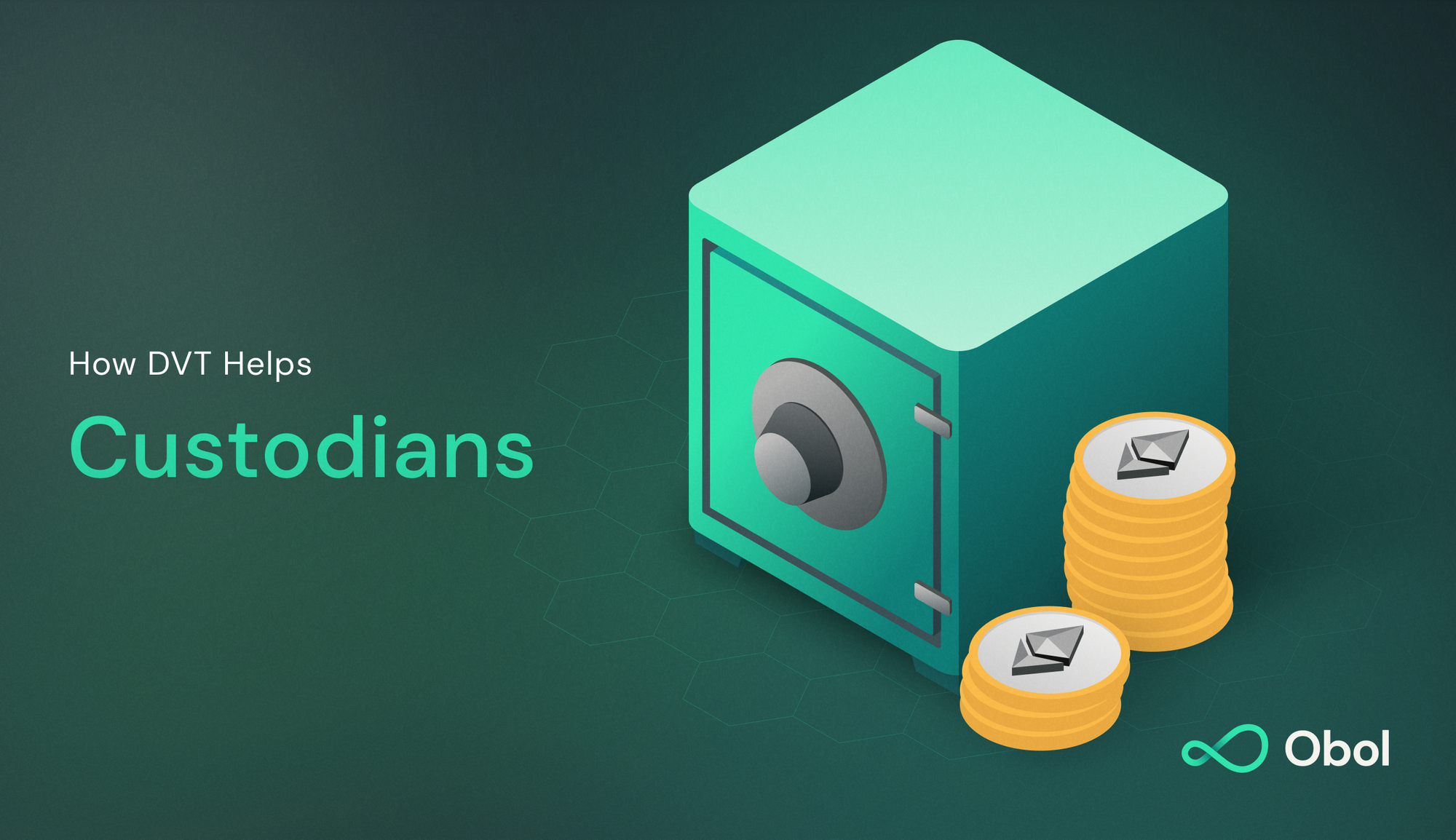How DVT Helps: Digital Asset Custodians
This is part 3 in a multi-part series that explores how DVT helps the different types of entities in the Ethereum staking ecosystem. In this article, we visit an increasingly important segment of the community: Digital Asset Custodians.

As we inch closer to our V1 launch, we have been diligently exploring various segments of the staking ecosystem poised to derive substantial benefits from the implementation of Distributed Validator Technology (DVT). Among these, the custody market emerges as a perfect fit. This blog post aims to shed light on the potential DVT holds for custodians and how they can enhance the security of their Ethereum staking offerings by incorporating DVs into their staking provider stack.
Introduction
Born in 2021, Obol Labs has been steadily nurturing the growth of the Obol Network, leading the charge in advancing distributed validators (DVs) within the Ethereum ecosystem. Distributed Validator Technology enables a single Ethereum validator to operate seamlessly across a cluster of nodes working together. This provides an active-active redundancy, such that when a certain number of machines go down (i.e. 1 of 4, 2 of 7, 3 of 10, etc.), the distributed validator cluster can still operate normally.
Running a single validator across multiple machines improves the security and liveness of validators by enabling high-availability deployments. This also allows multiple individuals or organizations to come together and operate Ethereum validators collaboratively, significantly mitigating operational risk when running validators.
State of the Staking Industry
Since the completion of Shanghai, new staking deposits are at an all-time high.
The recent surge in deposits is largely driven by heightened institutional interest in staking ether. As these entities, and other custodians, often operate with a conservative risk profile, the growing demand from such sources underscores the importance of security as part of the assessment criteria they employ in their selection of staking services. Security is also the most critical value for a digital asset custodian. As we navigate this landscape, our primary focus for this article will be how DVT can enhance security for custodians’ staking offerings, thereby delivering value to their clients.
DVT: A key technology primitive for custodians
Digital asset custodians store, protect, and deploy their clients' assets. To do so, they employ a range of security measures like MPC wallets, encryption, cold storage, and other cybersecurity practices. The market potential for new stake within the custodian segment is substantial given the sheer size of assets under custody and the increased demand for staking ETH following the Shapella upgrade. For customers that are looking to earn interest on their digital assets, staking is the safest way to do so, but more can be done to ensure the security custodians can provide while staking. Custodians should adopt DVT as a standard security protocol in any Ethereum staking services they adopt.
The adoption of DVT introduces many benefits for custodians. Firstly, it substantially amplifies the security of staked assets under custody by mitigating reliance on a single staking provider. Operators can form multi-organization clusters to run validators, mitigating single-operator risk significantly. This not only instills trust among prospective and existing customers but also reinforces custodians' commitment to ensuring asset protection. In addition, when doing so, custodians are promoting decentralization - DVT serves as a powerful countermeasure against stake centralization by distributing stake across several operators, thereby aligning with Ethereum’s ethos. On top of these, Distributed Validators introduce operational efficiencies at scale by enabling rolling restarts, hardware redundancy, and driving slashing risk to near zero.
DVT also introduces protection against key compromise. One of the main events when deploying a DV cluster is the Distributed Key Generation ceremony. This synchronous process involves each operator in the distributed validator cluster, and it's designed to securely generate individual private key shares without ever constructing the full private key. This procedure, essential to achieving fault tolerance, ensures no single party has access to the full private key, enhancing the security of the entire operation.
Rounding off its benefits, a particularly attractive advantage of DVT is its potential to unlock substantial discounts in insurance premiums for staked assets held in custody. Given DVT's risk mitigation properties, custodians could secure valuable discounts on insurance against slashing or validator downtime. The determining factor will hinge on the proportion of ether staked using DVT-based infrastructure. This financial incentive serves to reinforce the compelling case for DVT adoption among these organizations.
Pushing Towards Multi-Operator Validation
As the staking industry matures, the shift towards multi-operator validation is becoming increasingly pronounced. Previously, the standard model was one-to-one - one custodian either running all their Ethereum nodes or delegating to a single operator. However, the inherent vulnerabilities and limitations of this system have led to a reevaluation, driving the industry, including custodians, towards embracing a multi-operator world for their staking operations.
The adoption of multi-operator validation is a testament to the industry's maturation and desire to improve network security and resilience. This approach drastically reduces the likelihood of single-point failures or malicious manipulations from operators. Moreover, it distributes operational responsibilities, alleviating the burden on individual operators and, consequently, paving the way for a more efficient system. The most effective way to achieve multi-operator validation today is through the use of DVs.
Obol Labs offers Distributed Validator Technology to the enterprise segment seeking to transition into multi-operator validation. As part of our Alpha release, several multi-operator clusters have been deployed leveraging DVT, with operators ranging from professional operators to individuals. With a broad geographical spread, these clusters enable operators to run validators from any corner of the world.
Closing Remarks
The importance of custodians in the new stake landscape cannot be overstated, making them a key focus of Obol's go-to-market strategy. As we march towards our V1 launch, we envisage a future where custodians are characterized by the enhanced security, robust decentralization, and heightened operational efficiency facilitated by this key technology primitive.
